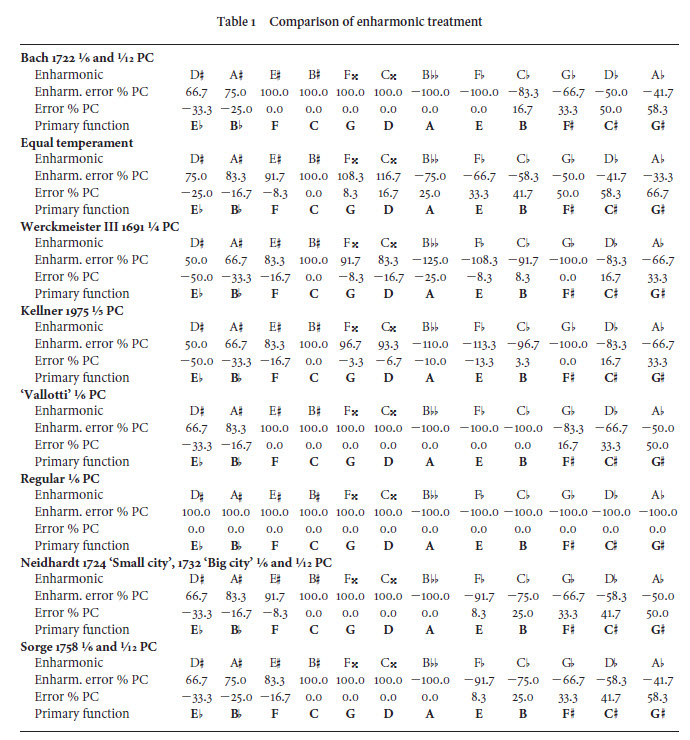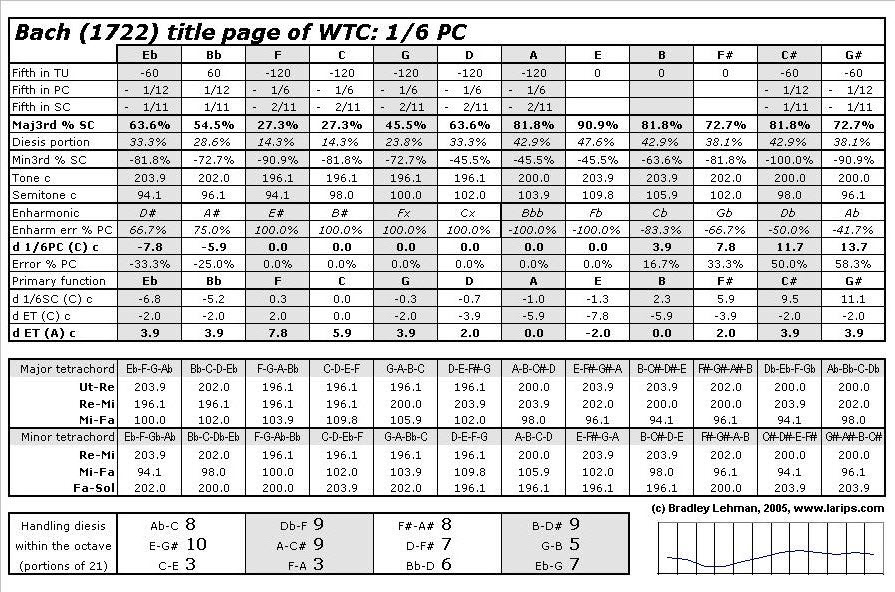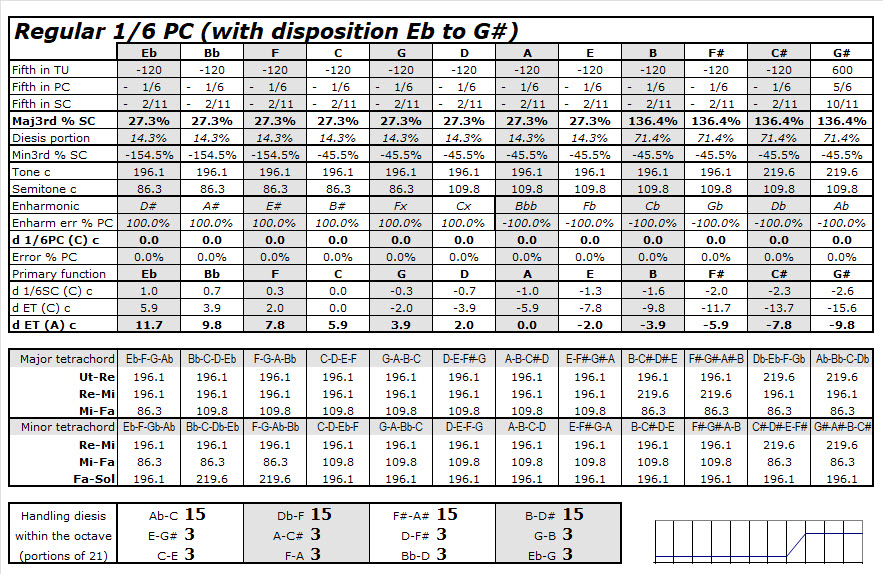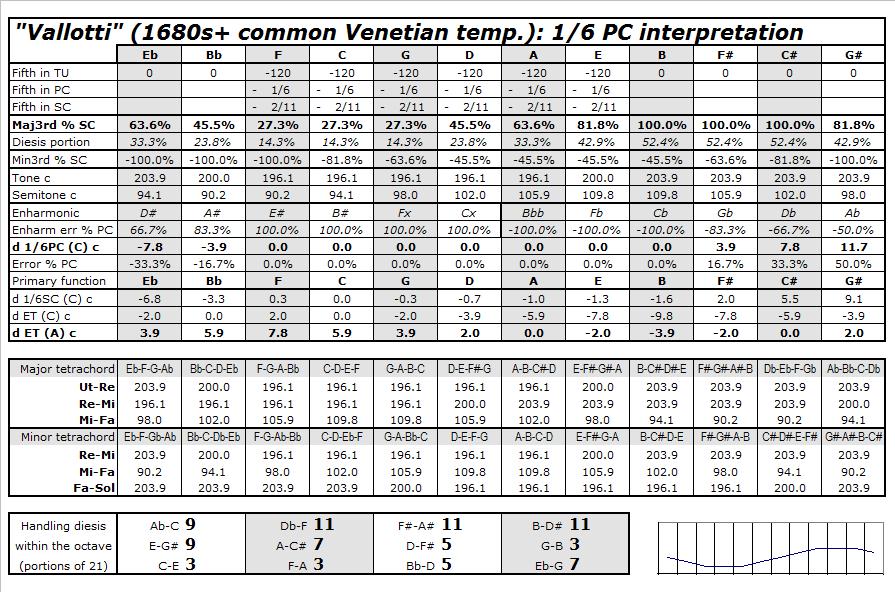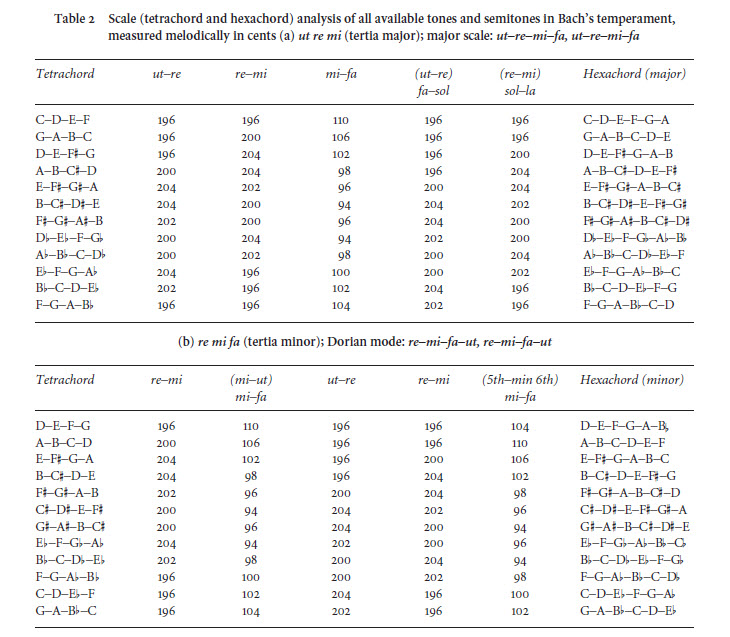 LaripS.com, © Bradley Lehman, 2005-22, all rights reserved. All musical/historical analysis here on the LaripS.com web site is the personal opinion of the author, as a researcher of historical temperaments and a performer of Bach's music.
Fa, Ti, and Modulation(Some of the illustrations....)My 2005 article "Bach's Extraordinary Temperament: Our Rosetta Stone" looked very mathematical at some places. It gave some readers the mistaken impression that the temperament is merely a set of formulas, or that Bach's drawing was only the pretext for calculations. Other readers missed the point that the enharmonic handling here is a vital part of the argument about matching temperaments to musical compositions. The music is itself part of the evidence, because it tells us what notes we must be able to play. A note such as C# belongs to diatonic scales such as D major, A major, E major, B minor, and others. The different note, Db, does not belong to those scales. It is a member of some other diatonic scales that do not have any C# in them. C# and Db make an enharmonic pair that never belong to the same scale, but they share one lever and one pitch on a keyboard. So, how do we tune that keyboard in a way that will let us play those notes either way, if we see that our music asks for the existence of both? I am showing the math from 2005 again here, briefly, to say that we are moving ahead to more important music theory that is about the way the notes behave within their scales. My point with the numbers was to measure what is happening melodically and harmonically when music is played using these temperaments. The aim was, and still is, to show how temperaments affect musical scales. The temperaments are set up by ear in a few minutes, and then we listen to them for hours or days. We don't hear numbers. We hear melodies and harmonies that either work passably, or that sound awkward (with temperaments that don't match the scale requirements of the music). Our Do-Re-Mi-Fa and our Sol-La-Ti-Do must make sense melodically...and to make that work properly, we must give plenty of attention especially to Fa, Ti, and Mi. Those are the notes that are most volatile whenever music is modulating from one scale to a different scale. First, we need to see a bit about the comma of error (difference in pitch) between notes of an enharmonic pair, such as C# and Db. If we are expecting the C# to sound good as Ti or Mi, and the Db to sound good as Fa, we need to look at the other notes around them in those scales.
That is the crux of the enharmonic problems set up by the music. How do we tune so all of the various occurrences of Fa, Ti, Mi, and all the other diatonic notes will make sense in scales, and in any harmonies that are built from those scales? The 2005 article included 44 tables (the three seen below, and 41 others) as part of its "Supplementary Data" files. For the printed sections of that article, there was space available for only this condensed table on page 215, as part of the "Enharmonics" section explaining it (214-218). The rows of percentages are drawn from these analyses in the "Supplementary Data" set: I drew data from the 41 other tables similarly. I explained the percentages within the available space. The background for all the percentage measurements is the row for "Regular 1/6 PC", the consistent tempering by 1/6 Pythagorean Comma (or, seeing it in another way, the 55-step division of the octave). If we tune a note such as Eb "purely" as Eb, it is 100% of a comma out of tune if we try to play that same pitch as D#. That D# is too sharp by that comma. If we tune a "pure" C# with 0 error, the Db has an error of -100%: the Db is a full comma too flat. In these other temperaments that modify some of the notes against that background of regularity, I measured the compromises where these pitches are pushed up or down part of the way toward the other enharmonic note. I showed how these tuning errors (fragments of a comma) are handled differently from note to note. For example, when we have set up a compromise where the note G# is 58.3% of a comma out of tune (too sharp), the corresponding note Ab is the other -41.7% of a comma out of tune in the other direction (too flat). These enharmonic errors between sharps and flats are the reality that must be dealt with as compromises whenever we have keyboards with only 12 notes per octave. Any particular pitch might sound "better" when played as a sharp than as a flat, or vice versa, but it is usable either way...as long as we have controlled the transitions carefully enough, within the ways that scales really work. In that section, I then showed that the temperaments that work well have their errors increase smoothly from note to note. The temperaments that don't work well (such as "Werckmeister III") move more haphazardly, as I explained. These measurements show why such temperaments sound crude. As I said with regard to such misshapen temperaments, "the misspelled notes simply stick out obtrusively, because their deviations from the 55-division skip across the set of notes rather than being well-organized outward from C." Now, in 2022, I am attempting to explain this more clearly without expecting everyone to see it as percentages, or as numbers. We hear these pitches within the context of music. The notes either sound "in tune" enough (i.e., fitting into the scales where they are use), or they sound "out of tune". The numbers from 2005 are still correct, but again, they are only measuring phenomena that are not merely mathematical. The numbers only describe the musical shapes we can hear whenever the harpsichord's pitches are set deliberately a little bit too sharp, or a little bit too flat, so those pitches can be played as notes with different names. The music demands that flexibility of renaming the notes. That is one of the reasons for the 2022 article, "The Notes Tell Us How to Tune": to explain all of this again with better emphasis on the scales and the hands-on compromises at a harpsichord...not the mathematical measurements that might have made it harder (rather than easier) for some readers to understand the enharmonic points. So, we will give more attention now to Fa, Ti, Mi, and the way we handle them through scales and modulations. Set aside those percentages of comma errors, because we don't need them anymore to keep moving forward with this. Those numbers are all in the background. When tuning and adjusting a harpsichord by ear, it is a process of listening to scales and harmonies, not doing anything with numbers. We can tune a harpsichord or tie a pair of shoes without measuring anything. We just have to get the shapes and the motions right. The process is:
Those pure naturals and the other compromises are like this, looking back at the percentage numbers from 2005: [For more on the 55-division and 1/6 comma, read the bigger articles....] (More illustrations, and their explanations will be here soon....) (The remaining parts of the text are to be posted in December 2022 with everything hyperlinked; drafted 2021 as a section of a longer article, "The Notes Tell Us How to Tune") See also the presentation of test pieces surveying Bach's keyboard music.  |
v Introduction v Articles v FAQ v Practice > Theory - Measurements - Comparisons - Other "Bach" - [Extra]ordinary - Regular/Mean - Enharmonics - Cube puzzle - Geometric 5ths - TU & Schismas * Fa Ti Modulation v History v Etc v Recordings |
